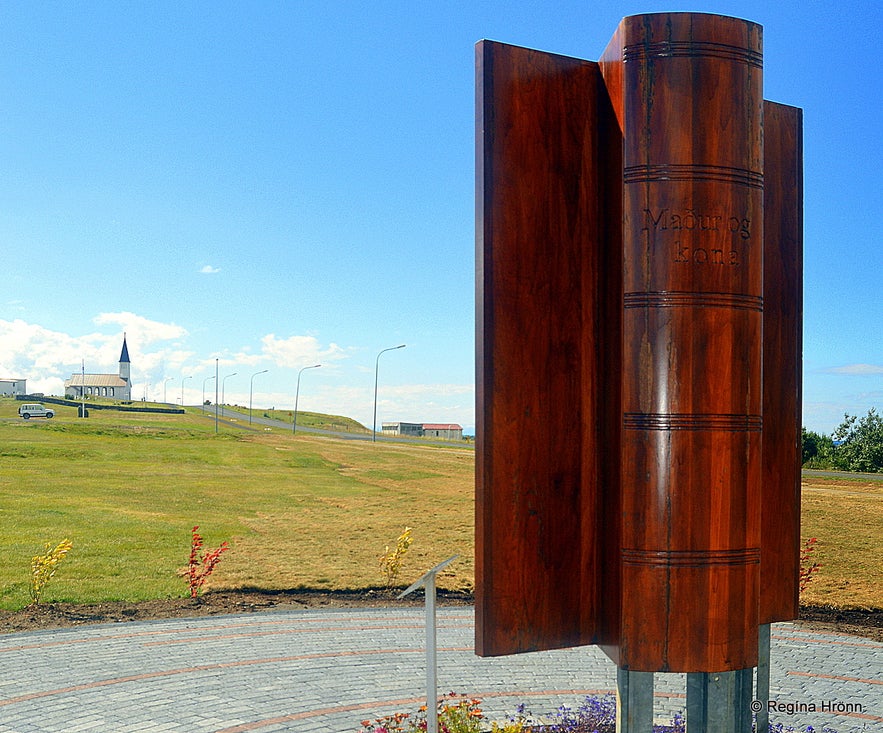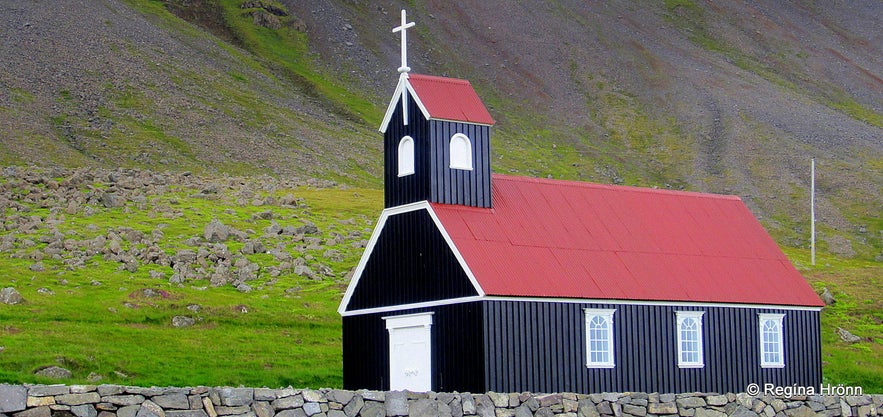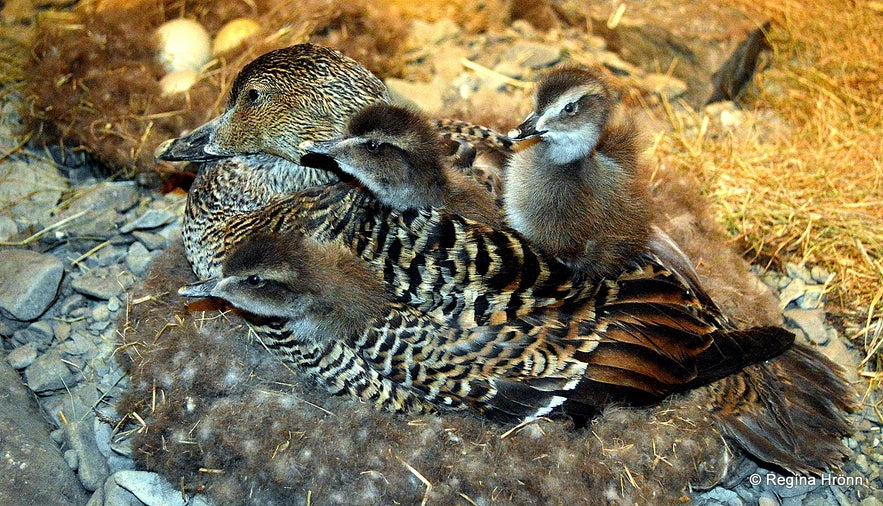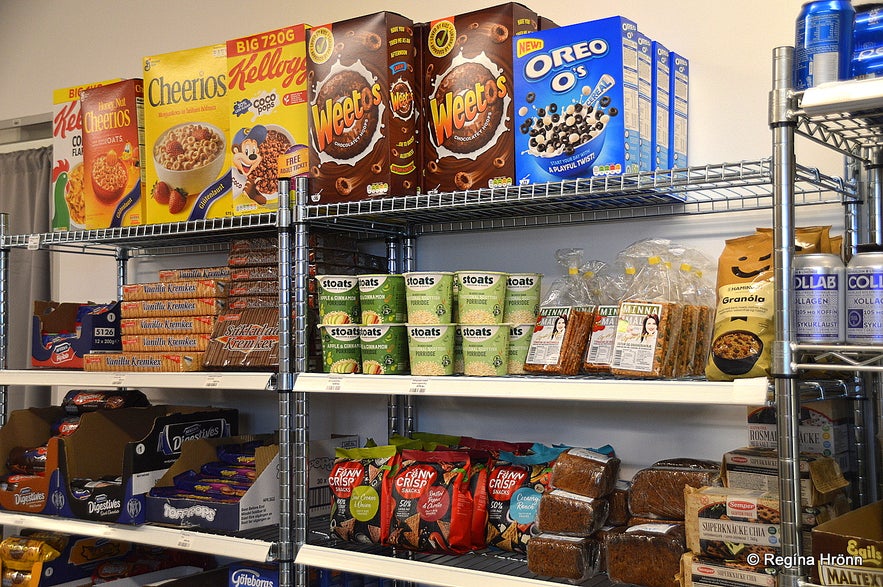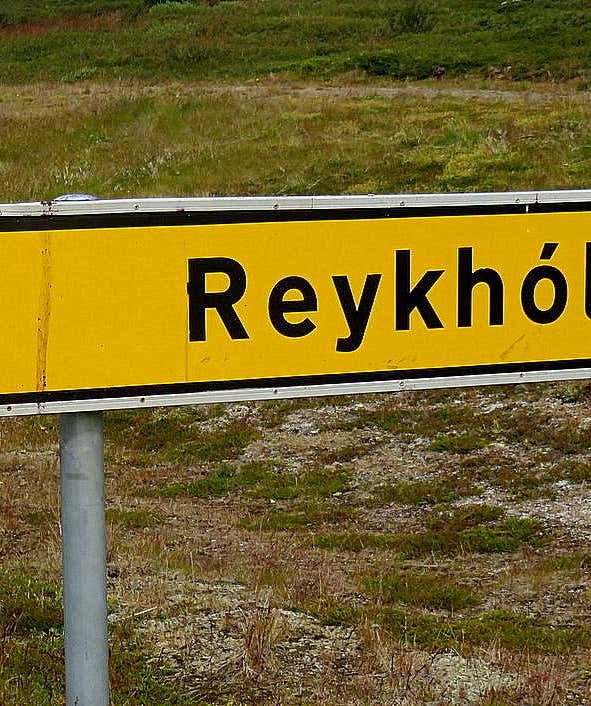
3 days of fun at Reykhólar in the Westfjords Region - Part 3

Reykhólar village has a population of 135 (2016) and the Reykhólahreppur county has a population of 271, give or take a few. It is a very peaceful community and I love the pretty signs they have put up to remind us to drive slowly and think of the children in the village.
The sign by the road, in the photo above, reads "think of the children".
And the sign below reads "don't drive fast or no speeding".
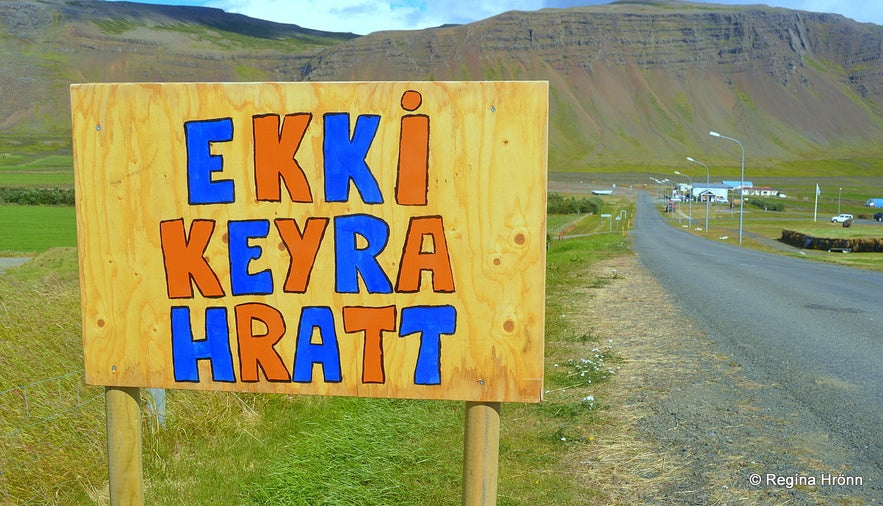
This is my 3rd travel-blog in my 3-part series on Reykhólar, where I had such a lovely stay. The other two travel-blogs are
A lovely 3-Day-Stay at Reykhólar in the Westfjords Region - Part 1 and a
A lovely 3-Day-Stay at Reykhólar in the Westfjords Region - Part 2 - the Seabaths.
In this area, you have a beautiful view of Breiðafjörður bay, which has so many islands that it is listed amongst the 3 innumerable places in Iceland. On the other side of the bay is Snæfellsnes peninsula and it is possible to see Snæfellsjökull glacier in the distance and Skarðsströnd on the other side of the bay.
Reykhólakirkja church
Reykhólakirkja church
Reykhólakirkja church is the landmark of Reykhólar, where it stands tall on the hill where the old Reykhólar farm was once located. It is a tastefully decorated Lutheran church, consecrated in 1963.
The church was open when I visited it, I guess the minister was in his office. But an incomprehensible incident took place in this church in May 2016 when 2 tourists had used this beautiful church as their place to sleep and had even cooked food in there - in a church with panelling and all this beautiful woodwork inside!
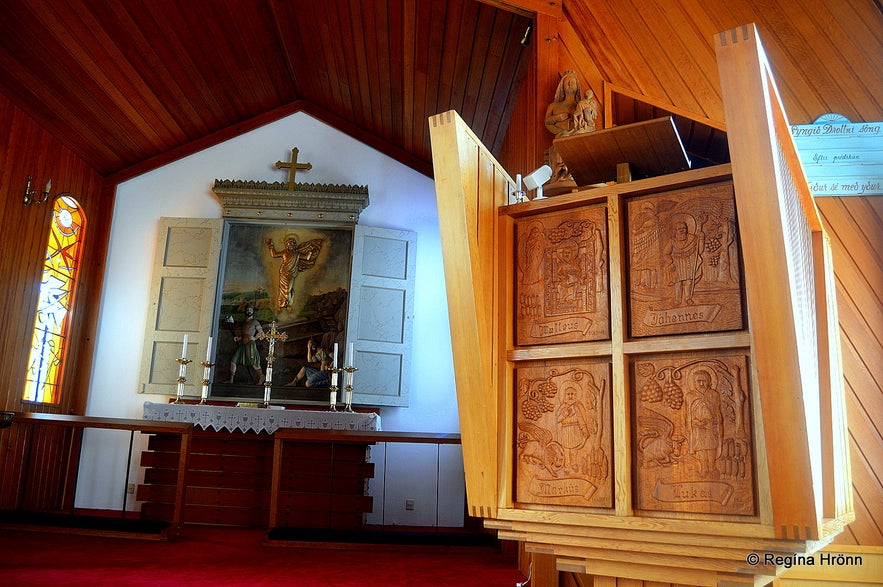
Reykhólakirkja church
They were told to leave in the morning but didn't seem to understand that it was not OK to sleep and cook in our place of worship. Since this incident, Reykhólakirkja church has to be closed and the inhabitants regret having to do so as this church is the focal point of social activities and worship in this area.
This was the second time such an incident took place in Reykhólakirkja church. Earlier this year (2016) when the minister went to work at the church she found tourists sleeping on the pews. They had cooked and even washed their clothes in the church! This makes me both sad and raving mad.
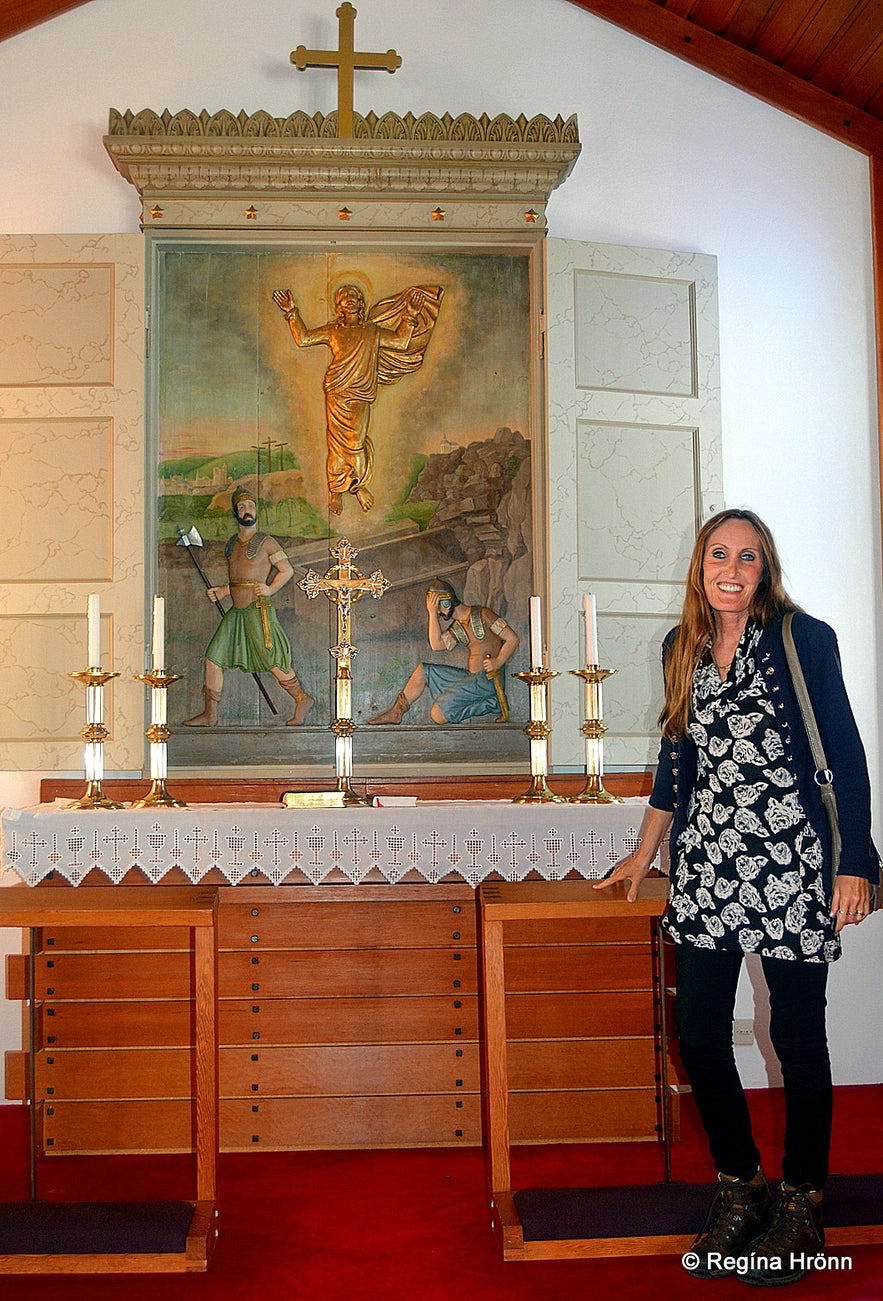
Reykhólakirkja church
So my plea to those who don't realize the importance our churches have to us: "Please respect our churches, they are holy to us and our place of worship".
I visit every church in Iceland on my travels in my country. I go in and pray and admire these beautiful churches, which to me are like gems scattered around my country.
The Monument for Jón Thoroddssen
The Monument for Jón Thoroddssen
One of our beloved poets, Jón Thoroddsen (1818-1868) was born here at Reykhólar. He brought the beautiful altarpiece in Reykhólakirkja church home with him from Denmark by a request from his mother.
Jón studied law in Copenhagen and worked for a time as the district judge of the southern part of the Westfjords Region. The altarpiece is by Lövener, painted in 1834.
You will see a noteworthy monument in Reykhólar - a huge wooden book. This is a monument in honour of the poet Jón Thoroddsen.

The Monument for Jón Thoroddssen
Jón was a pioneer in novel writing in Iceland and is often called the Father of the Icelandic novel. His novel Piltur og stúlka (1850) Lad and Lass, is the first Icelandic novel.
Jón Thoroddsen was also a well-known poet, and we learnt some of his beautiful poems by heart at school.
The Girl from Reykhólar - Icelandic Folklore
The old Reykhólakirkja church which was moved to Rauðasandur
I found this elf-story in Þjóðsögur Jóns Árnasonar - the Collection of Folklore of Jón Árnason about an elf-man and half an elf-child. It happened by and at the old Reykhólakirkja church:
"Centuries ago some people at Reykhólar went to pick some Iceland moss (fjallagrös) in a mountain. A thick fog suddenly appeared as they were picking the moss, and one of the girls in the group disappeared into the fog. She was lost for the whole summer.
A sorcerer was asked to find out about the girl's whereabouts with sorcery and get her back. The sorcerer succeeded in retrieving the girl and when the girl was back home, her employer the minister never let her be alone, but once it so happened that she was sent to the church.

The old Reykhólakirkja church which was moved to Rauðasandur
In a short while, her employer looked for her as he suspected some things, and as he entered the church the girl was gone; the minister looked around and saw a man in a red tunic riding away on a horse and the girl was sitting behind him on the horse.
Time passed and nobody knew anything about the girl's whereabouts, but once the minister's wife at Reykhólar dreamt of the man who had taken the girl away.
That man gave the minister's wife regards from his wife with the instructions that a child, who she would find lying in a crib in front of the church door when she woke up, should be christened - and the minister clothing on top of the crib should be a payment to the minister for the christening.

Reykhólakirkja church at Reykhólar
The minister's wife woke up and everything was as the hidden man had shown her in her dream; the crib was found in that specific place with the child in it - and on top of the crib was the rich clothing for the minister and a linen gown.
The minister then christened the child and it was put in the crib in the same way as it had been found. The minister took the rich clothing, but the linen gown was put on top of the crib. A little later the crib with the child was gone, but the linen gown was left behind.
(Translated into English from Þjóðsögur Jóns Árnasonar - the Collection of Folklore of Jón Árnason).
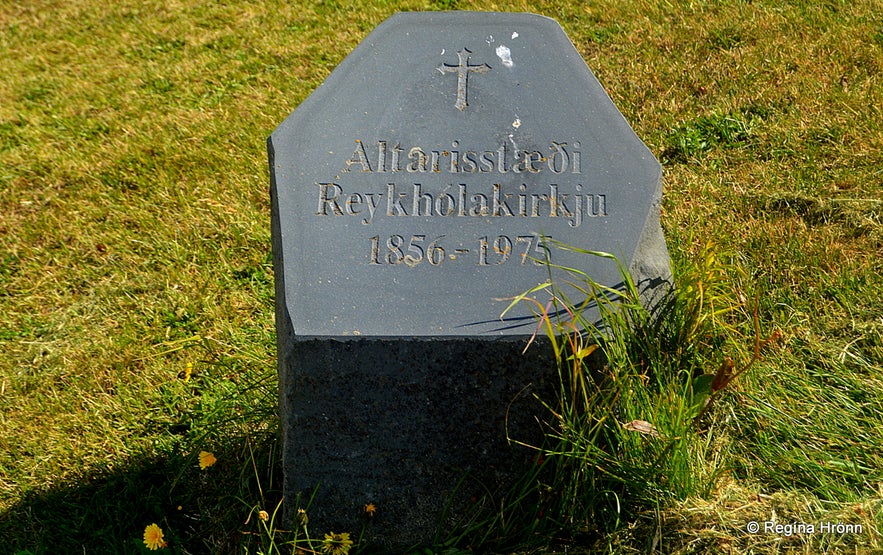
The site of the altar of the old Reykhólakirkja church
In the middle of the graveyard by the church, you will see the foundation of the old Reykhólakirkja church and a memorial showing the site of the altar of the old Reykhólakirkja church.
Written on the memorial stone is "Altarisstæði Reykhólakirkju 1856-1975", which means that this is the site of the altar of the old Reykhólakirkja church. The outlines of the old church can be seen around the memorial stone.
The new Reykhólakirkja church is now located on the spot where the old Reykhólabær farm used to be.
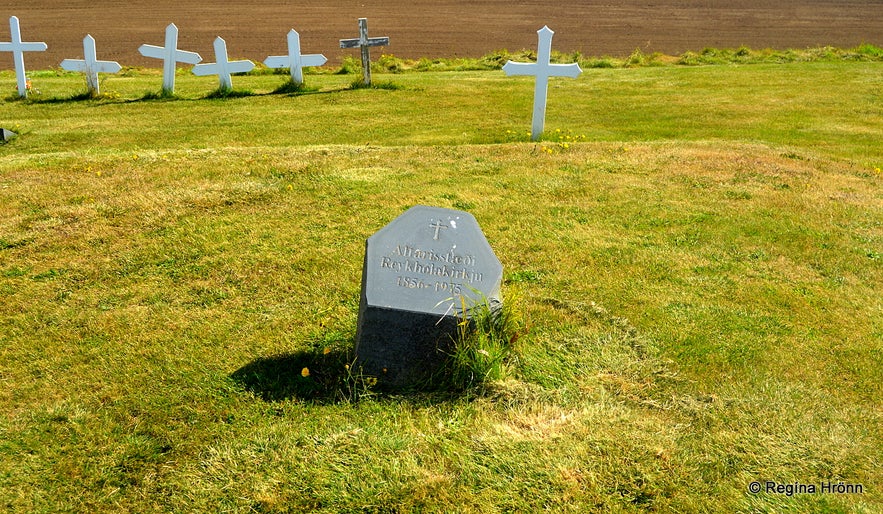
The site of the altar of the old Reykhólakirkja church
The old Reykhólakirkja church was built in 1856 and in 1975 it was moved to Saurbær in Rauðasandur. I have visited that old church at Rauðasandur, it is a lovely old black timber church with a red roof. You can see it in the photos above.
Just outside the Reykhólar cemetery walls, you will find an old grave. On the gravestone is written: "Tumi Sighvatsson D. 1244 "Sagður liggja hér"" which means that Tumi Sighvatsson, who died in 1244, is said to be buried here.
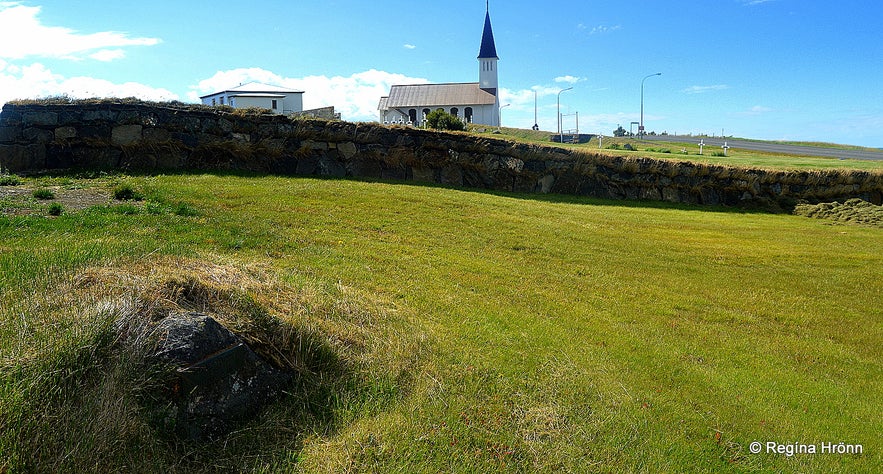
The grave of Tumi Sighvatsson at Reykhólar
Tumi Sighvatsson the younger (1222 - 19th of April 1244) was a member of the well-known Clan of the Sturlungs, which was one of the most powerful families in the Age of the Sturlungs. This period of time (42-44 years all in all) was the bloodiest in Iceland's history, with Viking clans fighting each other.
Tumi was the son of Sighvatur Sturluson, making him the nephew of the head of the Clan of the Sturlungs - Chieftain Snorri Sturluson himself.
Tumi fought in the biggest Viking battle in Iceland - the Örlygsstaðabardagi battle in the year 1238. In this gruesome battle, he lost his father and 4 of his brothers, but Tumi was able to flee from the battle to Eyjafjörður fjord. The chief of the Clan of the Ásbirningar, Kolbeinn ungi (the young), didn't bother following this 16-year-old boy.
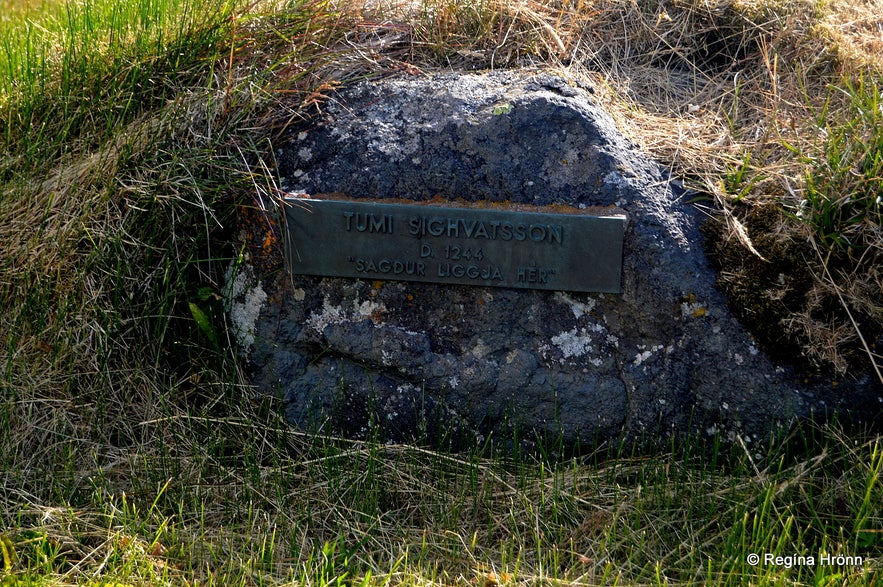
The grave of Tumi Sighvatsson at Reykhólar
Six years later Tumi was at Reykhólar in the spring of 1244 and there Kolbeinn ungi captured him and killed him (I have read that he was beheaded). Tumi was by then only 22 years old. And here this young man lies in this inconspicuous grave outside of the cemetery of Reykhólar.
Báta- og hlunnindasýningin - the Boat and Gift of Nature Exhibition
Boat and Gift of Nature Exhibition
The museum in Reykhólar is called Báta- og hlunnindasýningin or the Boat and Gift of Nature exhibition. Reykhólar is a settlement farm, meaning that the Vikings settled in this area back in the 9th century. The Vikings who settled at Reykhólar obviously knew what they were doing as this land (and sea) is filled with gifts of nature (perquisite) as it were.
The exhibition at Reykhólar shows which gifts of nature are found in this area - the landowners got plenty of riches from their land here. These gifts of nature were of great value in the olden time and being able to fish in lakes on your land and from the ocean, pick eggs and get eiderdown from the female eiders was invaluable - just to name a few of the extra resources of this land.
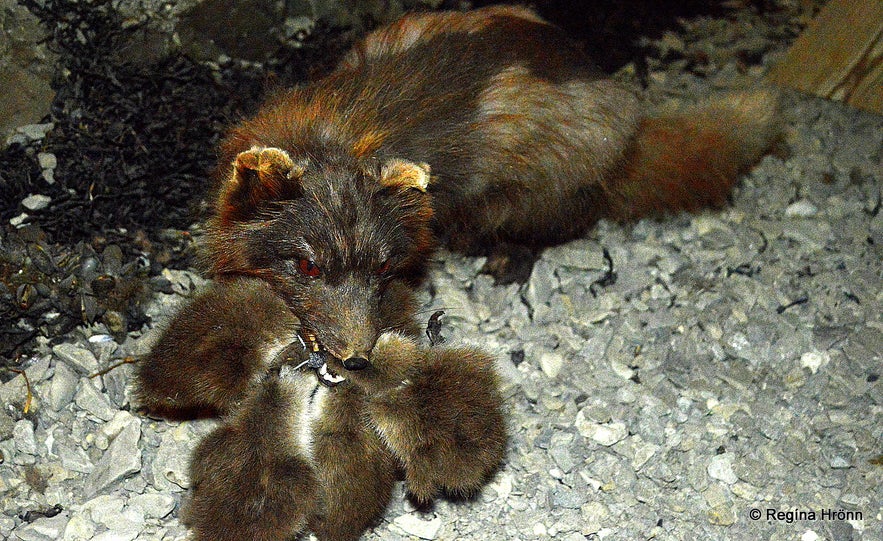
Boat and Gift of Nature Exhibition
Egg collecting, fowling etc was of great help to those who had to survive the harsh winters in Iceland - back then there were no grocery stores and they literally had to live from the land.
Also, those who were living close to the sea, as they were here in Reykhólar, were able to catch fish and hunt seal for food and use sealskin for warm clothes.
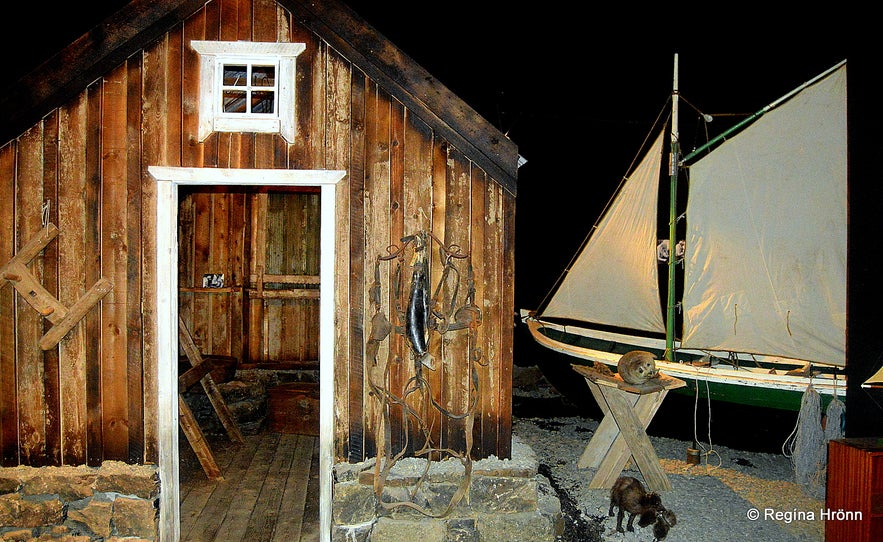
Boat and Gift of Nature Exhibition
The Boat and Gift of Nature exhibition is an eye-opener as one realizes how much people in the olden days relied on nature and the wildlife for their livelihood - do pay this exhibition a visit to get to know how people survived in Iceland through the centuries.
You will also see a collection of boats at the museum and on the ground floor, there is an impressive collection of boat engines on display.
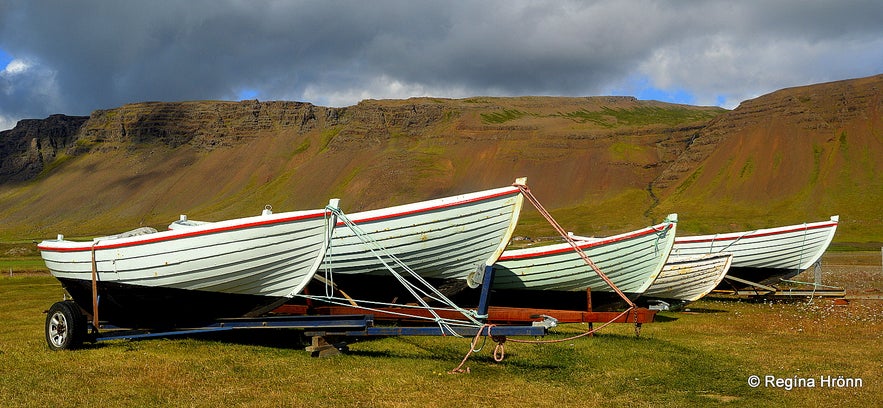
Boat and Gift of Nature Exhibition
The exhibition is open during the summer months, but it can be open by appointment in the wintertime.
Reykhólabúðin convenience store
Reykhólabúðin convenice store
Now that I have shown you around Reykhólar I want to tell you that there is a grocery store at Reykhólar with a wide variety of groceries.
In the summer of 2021, we visited Reykhólar again for the local Reykhóladagar festival, when the owners of the new store, now called Reykhólabúðin, asked my husband to do magic at the festival.
They told me that the former grocery store Hólabúð, had had to close down in 2020, thus leaving the inhabitants of Reykhólar without groceries and other necessities for 7 months!
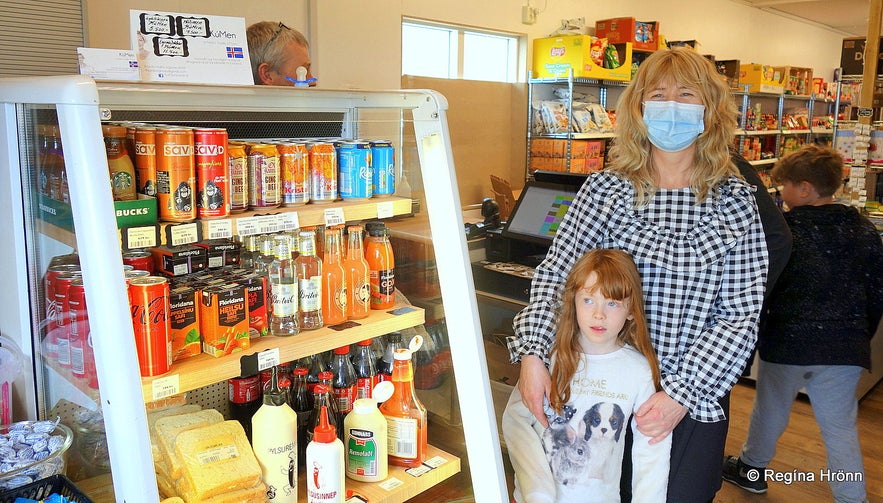
The lovely new owners of Reykhólabúð grocery store at Reykhólar
The next supermarket is at Hólmavík 57 km away and driving for 114 km is a long way to buy your groceries! Kudos to this lovely couple for opening up Reykhólabúðin grocery store so that the inhabitants of Reykhólar have access to groceries in their village.
They have redecorated the store and here you will find a cozy little café as well. I wish them all the best.
My husband had a magic show in the café which got filled with kids and kids at heart :)
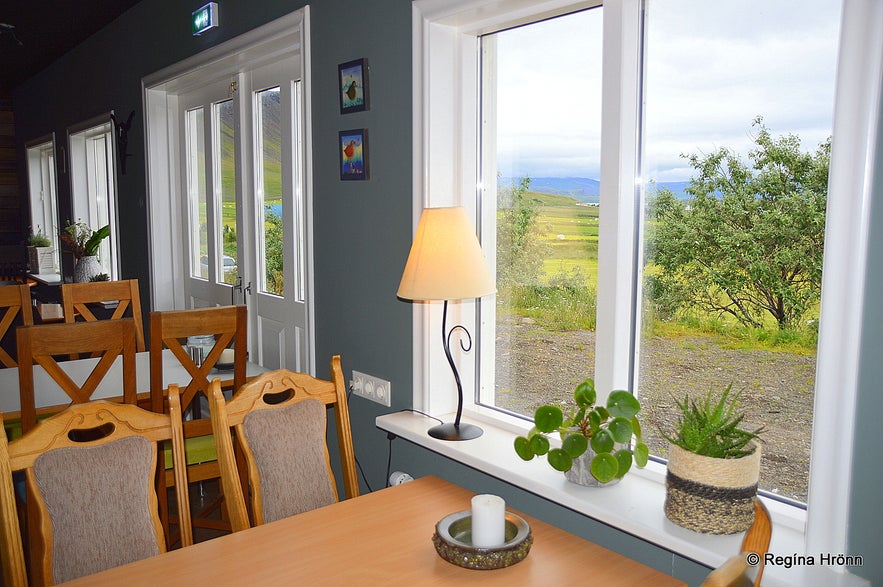
There is a lovely little café at Reykhólabúðin
Do pay them a visit and stock up on groceries for the day at this store, as if you are heading west the next supermarket is in Patreksfjörður village, 172 km (2 hours) away.
Just a couple more things - there are two places in the vicinity of Reykhólar which I would like to mention. There is an authentic turf house, Barmar turf house very close to Reykhólar. It is the only original turf house left in the Westfjords Region, in which people lived.
Seeing that I am searching for all the turf houses left in my country then I was thrilled to see the beautiful turf houses at Barmar. In 1925 Barmar had become dilapidated but was restored to its original form in a week by the owner and his neighbours. In 1967 Barmar turf house was abandoned.
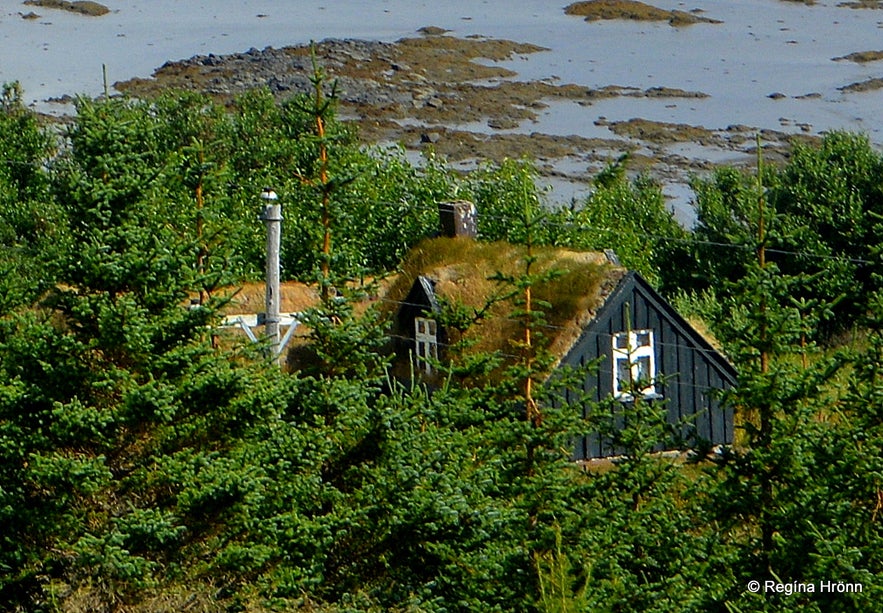
Barmar turf house - photo taken from the road above
A new owner put a lot of work, time, and effort into restoring this beautiful turf house with the help of professionals - kudos to them for a job well done. Barmar is privately owned and thus it is not possible to visit. But it is possible to take a peek at the turf house from above from the road, as you can see in my photo below.
There are also some outhouses made of turf left and in the remote Kollsvík, I found the oldest outhouse in the country, dating back to 1650.
See my travel-blog: A Visit to Kollsvík Cove in the Westfjords - the smallest Settlement in Iceland
The turf houses are our national inheritance, and I am very fond of them.
Reykhólar and its vicinity are filled with wonders and it was ever so nice coming back to Reykhólar Hostel in the evenings after a long day.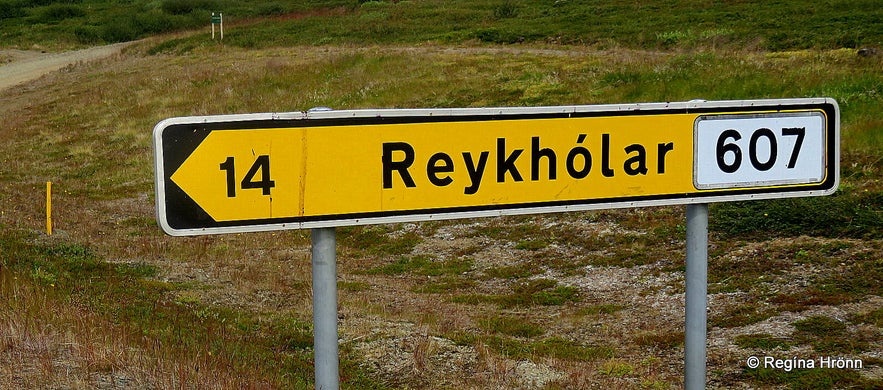
The Reykhólar road sign
Even though we always got in late at night we still got the chance to have a nice conversation in the living room with other guests in the hostel. This is what I love about hostels, the interaction with other travellers.
Reykhólar is for sure one of the hidden pearls of nature.
Reykhólar is located some 228 km away from Reykjavík which is a 3-hour-drive. To reach this area you can rent a car in Reykjavík and make Reykhólar your first overnight stay.
Have a lovely time at Reykhólar :)
其他有意思的博客
冰岛最浪漫的角落
对于很多人,遥远的冰岛有着世界尽头的神秘,有着区别于巴黎、马尔代夫、自成一体的浪漫。没有埃菲尔铁塔和蒂凡尼,没有热带沙滩,而是在冰川、火山、苔藓地的背景下蜜月旅拍、婚拍,甚至举办一场冰岛婚礼。来冰岛旅行,多是要跨千山万水、飞跃大洋大陆,很有一点“万水千山陪你走过”的史诗感。难怪很多人说,光是冰岛二字,就足够浪漫了。 冰岛虽然不大,但是地貌极其丰富,不同的自然景观自然有不同的气质。这一篇,就挑阅读更多从极光观测到摄影-到底该不该来冰岛看极光
很多朋友都想来冰岛看极光,但是冰岛到底适不适合看极光呢?几月、什么季节能看到极光?是不是一定要参加北极光旅行团?如何能拍摄出美丽的极光照片呢?在冰岛住了好几年了,从刚开始逢极光必出门,到如今家里阳台就能看极光,我对在冰岛看极光的了解和经验,也算得上大半个专家了,且听我娓娓道来吧。 到底该不该来冰岛看极光呢?最坦诚的答案是,不要只为了看极光而看极光。 极光原理 太阳活动→太阅读更多
迷失冰岛的米湖游览推荐|不只有温泉的地热宝藏区
我在冬夏秋均到访过米湖,看过米湖的不同面。一直以来,米湖到底值不值得去是很多游客争论的问题。有些人觉得这里是来冰岛旅行的必去目的地,有些人则说米湖“太丑了”,连照片都不想多拍几张。那米湖到底值不值得来呢?到底怎么玩呢? 米湖的风景 北部的米湖,因地理位置相距首都雷克雅未克略远,很多来冰岛的短途游客选择放弃,其实米湖应该是和黄金圈、南岸沿线至冰湖齐名的冰岛景色,这里冷热相融,可谓最冰岛,尤其阅读更多

将冰岛最大的旅行平台下载到您的手机中,一站式管理您的整个行程
使用手机摄像头扫描此二维码,然后点击显示的链接,将冰岛最大的旅行平台添加到您的手机中。输入您的电话号码或电子邮件地址,以接收包含下载链接的短信或电子邮件。


